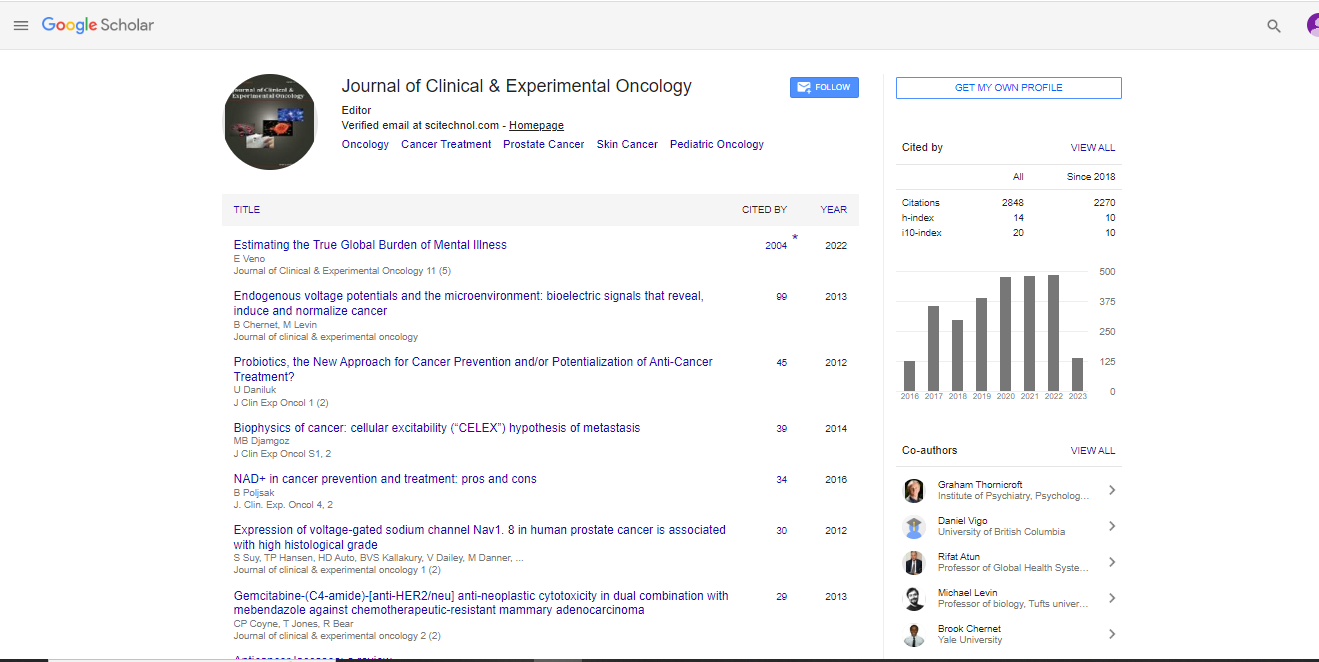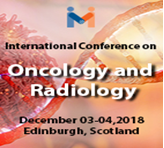Opinion Article, J Clin Exp Oncol Vol: 13 Issue: 6
Diagnostic and Prognostic Significance of Cytogenetic Markers in Cancer Therapy
Eline Gehrel*
1Department of Oncology, Oslo University Hospital, Oslo, Norway
*Corresponding Author: Eline Gehrel,
Department of Oncology, Oslo University Hospital, Oslo, Norway
E-mail: gehre@gmail.com
Received date: 27 November, 2024, Manuscript No. JCEOG-24-156853;
Editor assigned date: 29 November, 2024, PreQC No. JCEOG-24-156853 (PQ);
Reviewed date: 13 December, 2024, QC No. JCEOG-24-156853;
Revised date: 20 December, 2024, Manuscript No. JCEOG-24-156853 (R);
Published date: 27 December, 2024, DOI: 10.4172/2324-9110.1000443.
Citation: Gehrel E (2024) Diagnostic and Prognostic Significance of Cytogenetic Markers in Cancer Therapy. J Clin Exp Oncol 13:6.
Description
Cytogenetics, the study of chromosomal structure and abnormalities, has become an invaluable technique in cancer studies, diagnosis and treatment. Cytogenetic markers, specific chromosomal changes or abnormalities play a key role in understanding the biology of cancer. These markers provide valuable information into cancer diagnosis, prognosis and the development of modified treatment strategies. Cytogenetic markers include chromosomal abnormalities such as translocations, deletions, duplications, amplifications and aneuploidy (abnormal chromosome numbers). These abnormalities often disrupt genes that regulate cell growth, division and death leading to cancer development. The identification of such markers has made it possible to classify tumours and transformed cancer diagnosis based on their genetic profiles rather than solely on histological features.
Cytogenetic markers have become vital in diagnosing various cancers, as they allow for precise identification of malignancies based on specific genetic alterations. Chronic Myeloid Leukemia (CML) the Philadelphia chromosome, resulting from a reciprocal translocation between chromosomes 9 and 22 (t(9;22)), is a unique cytogenetic marker of CML. Its detection through techniques such as Fluorescence In-situ Hybridization (FISH) or Polymerase Chain Reaction (PCR) confirms the diagnosis. Cytogenetic markers also assist in subtyping cancers for more specific treatment approaches. In breast cancer, HER2 gene amplification detected by FISH or immunohistochemistry classifies HER2-positive cancers, regulating the use of HER2-targeted therapies such as trastuzumab. In lung cancer, changes in ALK, ROS1 or EGFR genes inform treatment selection with targeted therapies.
Cytogenetic markers are used to monitor disease progression and response to therapy. Quantitative PCR (qPCR) can detect Minimal Residual Disease (MRD) in leukemia’s by measuring fusion gene transcripts. Cytogenetic markers provide essential information about the likely course of a cancer, impacting treatment decisions and patient counseling. Certain cytogenetic abnormalities are associated with specific prognostic outcomes. In Acute Lymphoblastic Leukemia (ALL), hyperdiploidy (extra chromosomes) is linked to a favorable prognosis, whereas the t(9;22) translocation indicates a poorer outcome. In multiple myeloma, abnormalities such as del(17p) or t(4;14) are markers of high-risk disease. Cytogenetic markers can predict how a patient will respond to specific therapies. For example, in colorectal cancer, Rat Sarcoma (RAS) mutations predict resistance to Epidermal Growth Factor Receptor (EGFR) targeted monoclonal antibodies. Markers such as MYC gene amplification in certain lymphomas or mutations across various cancers are often associated with aggressive disease and shorter survival times.
These markers help oncologists design more severe treatment therapies for high-risk patients. Advances in technology have significantly improved the detection of cytogenetic markers. Karyotyping is a traditional method for visualizing whole chromosomes and identifying structural abnormalities such as translocations or deletions. Flourescence In-situ Hybridization (FISH) is a technique that uses fluorescent probes to detect specific DNA sequences on chromosomes, permitting the identification of gene rearrangements or amplifications. Comparative Genomic Hybridization (CGH) is used to detect copy number variations across the genome. Next-Generation Sequencing (NGS) provides a thorough analysis of genetic mutations, fusions and other alterations, allowing precision oncology.
Conclusion
Cytogenetic markers have transformed the field of oncology, providing powerful tools for cancer diagnosis, prognosis and therapy. By providing information into tumor biology, these markers provide more precise and specific treatment methods, improving outcomes for patients. Continued advancements in detection techniques and studies into new markers will further enhance the role of cytogenetics in treating cancer and changing the future of oncology.
 Spanish
Spanish  Chinese
Chinese  Russian
Russian  German
German  French
French  Japanese
Japanese  Portuguese
Portuguese  Hindi
Hindi 



